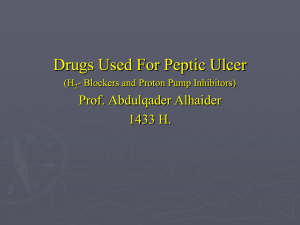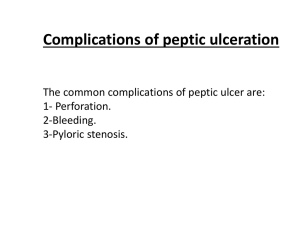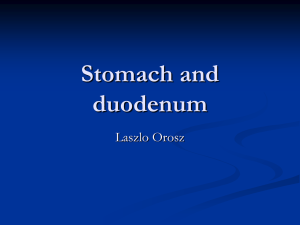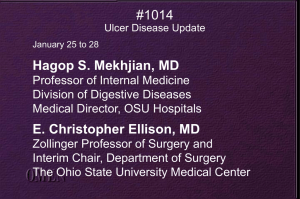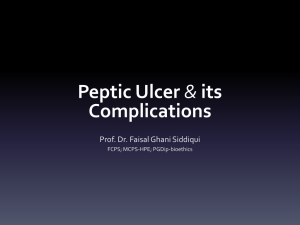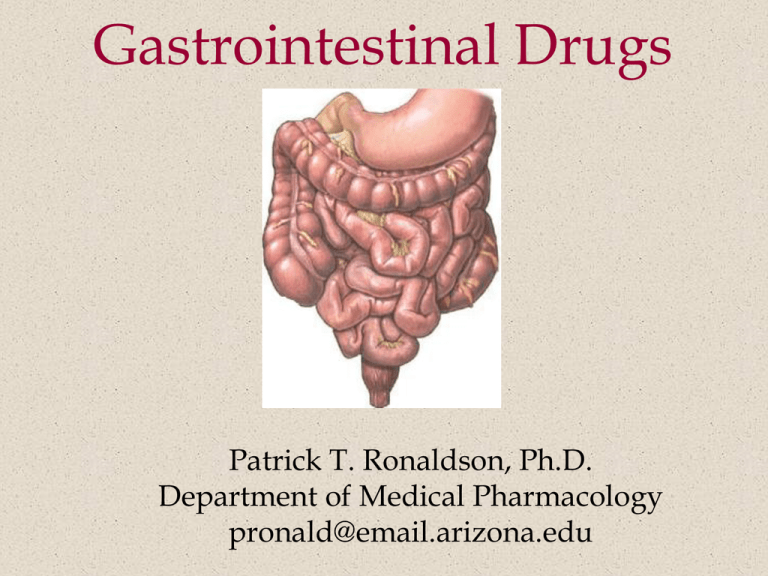
Gastrointestinal Drugs
Patrick T. Ronaldson, Ph.D.
Department of Medical Pharmacology
pronald@email.arizona.edu
Topics for Discussion
• Drugs for Acid-Peptic Disorders
– Eradication of Helicobacter pylori (Antibiotic/Inhibition of
Acid)
– Proton Pump Inhibitors (Omeprazole)
– Histamine (H2) Receptor Antagonists (Cimetidine,
Ranitidine)
– Anticholinergics
– Prostaglandins (Misoprostol)
– Antacids
– Mucoprotective Drugs (Sucralfate)
• Drugs for Motility Disorders
– Prokinetics (Metoclopramide)
– Laxatives (Bran)
– Antidiarrheals (Opioids)
What is GERD?
•Gastroesophageal Reflux Disease (GERD):
GERD is when acid and pepsin from the
stomach flows backward up into the esophagus
often called heartburn;
Approximately 10-20% of Americans
experience GERD symptoms every day.
- One of the most common medical
conditions.
- Source: El-Serag (2007). Clin
Gastroent Hepatol. 5: 17-26.
What Causes GERD?
1) Overproduction of acid/pepsin
2) Over relaxation of the Lower Esophageal
Sphincter (LES);
Complications;
if not treated - severe chest pains, bleeding or a
pre-malignant change in the lining of the
esophagus called Barrett’s esophagus – can
result in adenocarcinoma
Barrett’s Esophagus
•
Demarcated by histological
changes in cells lining the
esophagus.
•
Occurs in 10% of GERD
patients.
•
Incidence is 1% in the
general population.
•
Associated with
adenocarcinoma of the
esophagus.
Lower esophagus lined
by red-coloured tissue,
not the usual white-pink
colour.
Cameron. 2002. Diseases of the esophagus. 15: 106-108.
What is Peptic Ulcer Disease
• Definition of Peptic Ulcer:
A benign lesion of gastric or duodenal mucosa
occurring at a site where the mucosal epithelium is
exposed to acid and pepsin;
1) Excess acid production
2) Intrinsic defect in the mucosal defense barrier
Peptic Ulcer Disease
25 million Americans suffer from peptic ulcer disease
Each year there are 500,000 to 850,000 new cases
More than one million ulcer-related hospitalizations.
Average size ¼ and ½ inch in diameter
U.S. - duodenal ulcers are three times more common
than gastric ulcers.
A Gastric Peptic Ulcer
Who Gets Peptic Ulcers
• Peptic Ulcer Disease Affects All Age Groups
– Can occur in children, although rare
– Duodenal ulcers tends to occur first at around the age 25 and
continue until the age of 75
– Gastric ulcers peak in people between the ages of 55 and 65
• Men Have Twice The Risk as Women Do
• Genetic Factors
– High levels of acid production, weakness in mucosal layer,
abnormal nonprotective mucus production
• Increase Acid Production and/or Decrease in Bicarbonate and PG
Production
– Caffeine, Cigarettes, Alcohol, Fruit Juices, Stress
What Causes Peptic Ulcer Disease
• Helicobacter Pylori (H. pylori)
– Most ulcers are the result of infection with H.
pylori
– Not all of those infected with H. pylori develop
ulcers
– H. pylori MAY result in a weakening of the
mucosal defense systems, allowing for
development of ulcer subsequent to acid/pepsin
aggression;
What Causes Peptic Ulcer Disease
•NSAIDs
Long term use of nonsteroidal anti-inflammatory
drugs. NSAIDs block COX enzymes and
decrease prostaglandins (PGs).
•Gastrinoma (Zollinger-Ellison Syndrome)
Tumors of the duodenum or pancreas and
secrete abnormally high amounts of gastrin
which stimulates gastric acid.
•Stress ulcers
Result of physical trauma (i.e., burn patients).
Pathophysiological Processes Involved in
Duodenal and Gastric Ulcers
Duodenal Ulcer
Gastric Ulcer
HP
NSAID
Cancer (ZE)
Other
Helicobacter pylori
Spiral shaped, flagellated, Gram negative bacterium
Barry Marshall, M.D.
Helicobacter pylori on gastric mucussecreting epithelial cells
H. pylori Adapted to an Acidic Environment
•
Primarily colonizes in the antrum of the stomach;
•
Resides mainly within the gastric mucus;
•
Has a high activity of the enzyme urease which
enables it to colonize in the stomach.
Role of H. pylori in Peptic Ulcer Disease
• Transmission:
– Thought to be spread by fecal-oral route;
– Possible ?oral-oral transmission?;
– Infection thought to occur between parents and young
children;
• Additional Notes:
– Correlated with socioeconomic status;
– Almost universal infection in developing countries;
– Most of those infected are asymptomatic.
Percentages of Population Infected with H.
pylori
www.helico.com
Role of H. pylori in Peptic Ulcer Disease
•The host reaction to H. pylori determines the
outcome of the infection:
– Gastritis
– GERD
– Gastric & Duodenal Ulcers
– Gastric Cancer (?)
Prevalence of H. pylori Infection in the U.S.
HPHP+
Duodenal
ulcer
Gastric
lymphoma
Gastric
ulcer
Gastric cancer
Role of H. pylori in Peptic Ulcer Disease
•Diagnosis:
–The majority cases of peptic ulcer disease are
related to H. pylori.
–The diagnosis of H. pylori infection must be
confirmed prior to initiation of therapy
(histology and culture, antibody test, urease
CLO test)
Urease CLO test (PYtest)
Cost of test $50-$100
www.helico.com
What Causes Peptic Ulcer Disease
• Helicobacter
Pylori
• NSAIDs
• Gastrinoma
• Stress
(Zollinger-Ellison Syndrome)
ulcers
Cyclooxygenase Pathway
Arachidonic Acid
COX-1
Thromboxane
Synthase
Thromboxane A2
Thromboxane B2
Prostaglandin H2
Prostaglandin G2
Prostacycline
Synthase
Prostaglandin
Synthase
Prostacycline E2, F2
Prostacycline G2
RESULT = DECREASED ACID SECRETION &
INCREASED MUCUS PRODUCTION
Prostacycline PG12
NSAID Induced Ulcers
The Physiological & Cellular
Production of Gastric Acid and Pepsin
Neuroanatomy of the GI
Olfactory
bulb
Olfactory
tract
Olfactory
epithelium
Thalamus
& Insula
Hypothalamus
& Amygdala
Parabrachial
nucleus
Vagal Nucleus
CNS Conditioned
Reflexes:
1) Nucleus Tractus Solitarius
(NTS);
2) Hypothalamus;
Ach
3) Dorsal Motor Nucleus of
the Vagal Nerve (DMNV)
Ach
Reflexes Include:
Smell, Taste, Chewing,
Swallowing &
Hypoglycemia
Gastric lumen
Mucus
Superficial Epithelial Cells
Found in the
Body and Fundus
of the Stomach
Mucous Neck Cells
Parietal Cells
Peptic Cells
(also known as Chief Cells)
Muscularis Mucosa
Acetylcholine, Gastrin and Histamine
Stimulate Parietal Cell Secretion of Acid
Cholinergic
Neuron
Ach
Cholinergic
Neuron
Enterochromaffinlike Cell
Ach
Antral G Cell
Ach
Ach
Parietal Cell
H
G
G
G
G
G
G
G
Acid
H
G
Circulation
G
G
Vagal Nucleus
CNS Conditioned
Reflexes:
Ach
Parietal Cell
Ach
H+
Histamine
G-cell
Gastrin
1) Nucleus Tractus
Solitarius (NTS);
2) Hypothalamus;
3) Dorsal Motor Nucleus
of the Vagal Nerve
(DMNV)
Reflexes Include:
Smell, Taste, Chewing,
Swallowing &
Hypoglycemia
Multiple Mechanisms Regulate Gastric
Acid
•Neural
Acetylcholine
•Hormonal
Gastrin
•Paracrine
Histamine
Each Secretagogue Binds to its Own
Receptor and Interacts with the Others
CCK2
Gastrin
H2
Histamine
cAMP dep. pathway
M3
Acetylcholine
PP
H+
Gastric
Lumen
Strategies for Protecting the Gastric Mucosa
from Acid Exposure
Mechanisms
H+
H+
H+
Example
Cimetidine
Inhibit
Omeprazole
secretion
Prostaglandins
Muscarinic antagonists
Prevent
contact
Sucralfate
Neutralize
acid
Antacids
Strategies for Inhibiting Parietal Cell Acid
Secretion
Gastrin
Antagonists
CCK2
H2
Histamine
Antagonists
↓cAMP
M3
Muscarinic
Antagonists
PP
H+
Gastric
Lumen
Strategies for Inhibiting Parietal Cell Acid Secretion
Apical
Basolateral
H2
cAMP
Histamine
(+)
(+)
Protein
Kinase
EP3
ATP
(-)
K+
H+
PP
(-)
cAMP
PGI2
PGE2
EP3
Parietal Cell
M?
Mucus
Superficial Epithelial Cell
HCO3pH 6.7
pH 2
CCK2
Strategies for Inhibiting Parietal Cell Acid
Secretion
H2
EP3
Ca2+
(-)
cAMP
(+)
Protein
Kinase
ATP
M3
Proton pump
Inhibitors
Ca2+
PP
H+
H+, K+-ATPase (the proton pump) is the final
transport pathway for parietal cell hydrogen
ion secretion
•
H+, K+-ATPase is located in the apical membrane of
the oxyntic cell along the secretory canaliculi;
•
The pump requires large amounts of energy that is
supplied by intracellular ATP;
•
Inhibition of H+, K+-ATPase blocks both basal and
stimulated acid secretion.
Omeprazole (Prilosec)
•
Prototype H+, K+-ATPase inhibitor; A prodrug that needs
a low pH to be active;
•
Irreversible (forms a covalent bond with the proton pump)
- long lasting inhibition of acid production;
•
Profound reduction of gastric acid - elevates gastric pH
significantly (20mg/day for 7days will decrease acid by
95%);
•
Highly protein bound; Metabolized by CYP2C &
CYP3A; plasma half life of 1 to2 hours but long duration
of action; Should be taken just prior to a meal and should
NOT be taken with other acid-suppressing agents.
Esomeprazole (Nexium)
Simply the S-isomer of omeprazole;
H+, K+-ATPase inhibitor;
Given orally.
Rabeprazole (Aciphex)
Lansoprazole (Prevecid)
H+, K+-ATPase inhibitor;
Given orally.
Pantoprazole (Protonix)
H+, K+-ATPase inhibitor;
An acid-stable form and can be given by i.v.
Proton Pump Inhibitors (PPI)
Well Tolerated
Hypergastrinemia
(can lead to tumor growth in the GI)
Nausea
Headaches, skin rashes
CCK2
Strategies for Inhibiting Parietal Cell Acid
Secretion
(-)
cAMP
ATP
M3
Histamine
Antagonist
H2
EP3
Ca2+
Ca2+
Protein
Kinase
PP
K+
H+
Histamine Receptors
•H1 receptors
– Smooth muscle
– Nerves
•H2 receptors
– Parietal cells
Histamine H2 Antagonists Decrease Acid Output
Histamine
cAMP
Protein
Kinase
K+
H+
PP
ATP
H2 antagonist administered
orally at arrow
30
Acid Output
(mEq/hr)
Histamine
Antagonist
20
10
Time (hr)
1
2
3
4
5
Histamine H2 Antagonists
•
Cimetidine (Tagamet)
•
Ranitidine (Zantac)
•
Famotidine (Pepcid)
•
Nizatidine (Axid)
Drugs for Acid-Peptic Disorders
- Cimetidine (Tagamet)
• Competitive H2 receptor Antagonist;
• Markedly inhibits basal acid secretion including
nocturnal secretion;
• Readily absorbed after oral administration;
• Relatively brief duration of action (4-8 hr)
– Given on a multiple dosing schedule;
– (300-400 mg, 2-4 times daily);
– Typical therapy is for 4-8 weeks.
Drugs for Acid-Peptic Disorders - Cimetidine
(Tagamet)
• Side effects include inhibition of the microsomal
metabolism of other drugs
results in higher blood levels and enhancement of their effects
– Interactions have been shown with:
Diazepam
Chlordiazepoxide
Theophylline
Phenytoin
Warfarin
Propranolol
Meperidine
Pentobarbital
Lidocaine
and many others...
Drugs for Acid-Peptic Disorders - Cimetidine
(Tagamet)
Additional Side effects:
• In some patients, cimetidine acts as a nonsteroidal
antiandrogen (i.e., interferes with estrogen metabolism).
decrease in male sexual function
gynecomastia (swelling of the breasts and soreness of
the nipples in males)
• Can produce confusion and disorientation in elderly
patients;
• Diarrhea, rash and miscellaneous other effects in a small
number of patients.
Drugs for Acid-Peptic Disorders - Ranitidine
(Zantac), Famotidine (pepcid), Nizatidine
(Axid)
• Same mechanism of action as Cimetidine but a longer
duration of action (8 to 12 hrs);
• Can be given less frequently;
150 or 300 mg, 1-2 times daily
• Less interactions at P450 than Cimetidine.
Top Selling Prescription Drugs (1996)
1. Zantac (Ranitidine)
2. Procardia (blood pressure)
3. Mevacor (cholesterol)
4. Vasotec (blood pressure)
5. Prozac (depression)
6. Cardizam (blood pressure)
7. Tagamet (Cimetidine)
8. Premarin (estrogen)
9. Cipro (antibiotic)
10. Prilosec (Omeprazole)
11. Capoten (blood pressure)
12. Pepcid (Famotidine)
13. Naprosyn (arthritis)
14. Ceclor (antibiotic)
15. Xanax (anxiety)
16. Seldance (antiallergic)
17. Augmentin (antibiotic)
18. Zovirax (antiviral/herpes)
19. Zoloft (antidepressant)
20. Humulin (diabetes)
Top Selling Prescription Drugs (2000)
1. Prilosec (Omeprazole)
2. Lipitor (cholesterol)
3. Prevacid (Lansoprazole)
4. Prozac (depression)
5. Zocor (cholesterol)
6. Celebrex (analgesic)
7. Zoloft (depression)
8. Paxil (depression)
9. Claritin (antihistimine)
10. Glucophage (diabetes)
11. Norvasc (heart failure)
12. Augmentin (antibiotic)
13. Vioxx (analgesic)
14. Zyprexia (antipsychotic)
15. Pravachol (cholesterol)
16. Premarin (estrogen)
46. Pepcid (Famotidine)
108. Axid (Nizatidine)
134. Zantac (Ranitidine)
???. Tagamet (Cimetidine)
Top Selling Prescription Drugs (2003)
(billions)
1. Lipitor (cholesterol) $6.3
2. Zocor (cholesterol) $5.1
3. Prevacid (GI) $4.4
4. Procrit (anemia) $3.2
5. Nexium (GI) $2.9
6. Zyprexa (antipsychotic) $2.8
7. Zoloft (depression) $2.8
8. Celebrex (analgesic) $2.5
9. Epogen (anemia) $2.5
10. Neurontin (analgesic) $2.0
Generic Drug
Sales (2003)
www.pharmacytimes.com
11.
12.
13.
14.
15.
16.
17.
18.
19.
20.
Advair Diskus (asthma) $2.2
Plavix (anticoagulant) $2.2
Norvasc (blood pressure) $2.1
Effexor XR (depression) $2.1
Aciphex (GI) $2.0
Protonix (GI) $2.0
Risperdal (schizophrenia) $1.9
Pravachol (cholesterol) $1.9
Vioxx (analgesic) $1.8
OxyContin (analgesic) $1.7
3. Ranitidine $0.71
38. Famotidine $0.19
51. Cimetidine $0.14
Gastrin
CCK2
Strategies for Inhibiting Parietal Cell Acid
Secretion
H2
EP3
Prostaglandin
Agonists
Ca2+
(-)
cAMP
Histamine
Acetylcholine
M3
ATP
Ca2+
Protein
Kinase
PP
K+
H+
Drugs for Acid-Peptic Disorders Anticholinergics
•Blockade of acetylcholine at muscarinic
(M3/M1) receptors
– Effectively blocks acid secretion (30 to 40%)
– Limited by side-effects
•Side-effects are typical of anticholinergics such
as atropine
– Dry mouth
– Tachycardia
– Blurred vision
– Bowel discomfort (constipation)
– Difficulty in urination
Drugs for Acid-Peptic Disorders Anticholinergics
• General muscarinic receptor antagonists
(block all types of muscarinic receptors)
– Atropine
– Propantheline (Pro-Banthine)
– Dicyclomine (Bentyl)
• Selective M1 receptor antagonists
– Pirenzepine
– Telenzepine
CCK2
Strategies for Inhibiting Parietal Cell Acid
Secretion
H2
EP3
Prostaglandin
Agonists
Ca2+
(-)
cAMP
M3
ATP
Ca2+
Protein
Kinase
PP
K+
H+
Drugs for Acid-Peptic Disorders –
Prostaglandins (PGE2 & PGI2 )
•
Act at prostaglandin EP3 receptors on parietal
cells & on epithelial cells
Inhibits:
– Acid secretion
– Gastrin release
– Pepsin secretion
Stimulates:
– Mucus secretion
– Bicarbonate secretion
– Mucosal blood flow
These compounds act by both inhibition of acid
production and by increasing defense mechanisms
•
These compounds are also effective against direct
damage produced by alcohol, aspirin and NSAIDs,
and are therefore termed “cytoprotective”
Drugs for Acid-Peptic Disorders Prostaglandins
Misoprostol (Cytotec):
•
•
•
•
Synthetic Analog of Prostaglandin E1
Anti-acid secretory
0.1 to 0.2 mg results in 85% to 95% acid reduction
Prevention of NSAID gastric ulcers
Side Effects
•
•
•
Diarrhea
Abortion
Exacerbate IBD and should not be given
Drugs for Acid-Peptic Disorders - Antacids
•
Antacids are weak bases that neutralize HCl in the
stomach;
•
They do not decrease the secretion of acid, and in some
cases increase secretion;
•
They do not suppress nocturnal acid secretion
1. Neutralize acid
2. Decrease acid load to duodenum
3. Diminish pepsin activity
Drugs for Acid-Peptic Disorders Antacids
• Magnesium hydroxide
• Magnesium
trisilicate
• Magnesium-aluminum
mixtures
• Calcium
• Sodium
carbonate
bicarbonate
Characteristics of Common Antacids
Sodium
Bicarbonate
Calcium
Magnesium
Hydroxide
Aluminum
Onset of
action
rapid
intermediate
rapid
slow
Duration of
action
short
moderate
moderate
moderate
Systemic
alkalosis
yes
?
no
no
Effect on
stool
---
constipating
laxative
constipating
Feature
Drugs for Acid-Peptic Disorders – Sucralfate
(Carafate)
•
Sucralfate is a basic aluminum salt of sucrose
octasulfate;
•
In the presence of acid (pH < 3-4) some of the aluminum
ions dissociate and the resulting negatively charged
molecule polymerizes to form a viscous paste-like
substance;
•
This substance adheres strongly to gastric and duodenum
mucosa and adheres even more strongly to partially
denatured proteins such as those found at the base of the
ulcer.
Drugs for Acid-Peptic Disorders - Sucralfate
(Carafate)
•This compound does not decrease the concentration
or total amount of acid in the stomach;
•Sucralfate protects the gastric and duodenal mucosa
from acid/pepsin attack.
Side effects:
• The compound is not really absorbed and, therefore,
side-effects are minimal:
– constipation
– diarrhea
– nausea
Role of H. pylori in Peptic Ulcer Disease
•Treatment
–If H. pylori detected, eradication of the
bacteria, along with inhibition of acid.
–Eradication of H. pylori is a cure as
reinfection rates in Western countries is
less than 1%.
Role of H. pylori in Peptic Ulcer Disease
•Combination therapy with Omeprazole and
Amoxycillin
Eradication of H. pylori reduces the rate of
duodenal ulcer relapse
Study
Year Follow up
(months)
Ulcer relapse (%)
H. pylori
Negative
Positive
Coghlan et al.
1987
12
76
10
Lambert et al.
1987
6
76
0
Marshall et al.
1988
12
81
12
Smith et al.
1988
18
80
0
Borody et al.
1988
12-25
100
0
Rauws & Tyt gat
1990
12
81
0
Blum et al.
1990
6
41
0
George et al.
1990
12-48
0
0
H. pylori Eradication Rates with Either Dual,
Triple or Quad Therapy (1999)
Treatment
Pooled Eradication
Rate
Dual Therapy
72%
Triple Therapy
85%
Quad Therapy
90%
H. pylori Eradication Rates with Either Dual,
Triple or Quad Therapy (1999)
GENERIC NAME
DOSING
DURATION
CURE RATE (%)
Dual therapies
omeprazole
amoxycillin
ranitidine
clarithromycin
lansoprazole
amoxycillin
500 mg TID
14 days
1,000 mg TID
14 days
70-80
400 mg BID
500 mg TID
28 days
14 days
73-84
30 mg TID
1,000 mg TID
14 days
14 days
66-77
H. pylori Eradication Rates with Either Dual,
Triple or Quad Therapy (1999) Cont.
GENERIC NAME
DOSING
DURATION CURE RATE (%)
Triple therapies
lansoprazole
amoxycillin
clarithromycin
30 mg BID
1,000 mg BID
500 mg BID
14 days
14 day
14 days
86-92
H. pylori Eradication Rates with Either Dual,
Triple or Quad Therapy (1999) Cont.
GENERIC NAME
DOSING
DURATION
Quad therapies
bismuth subsalicylate Two tablets
7 days
525 mg QID
metronidazole
250 mg QID
7 days
tetracycline
500 mg QID
7 days
omeprazole
20 mg BID
7 days
or
lansoprazole
30 mg BID
7 days
CURE RATE (%)
85-95
New Strains of H. pylori
•
Recently a more virulent genetic strain of H.
Pylori known as cytotoxin-associated gene A
(cagA) has been found in some people with
peptic ulcers
Drugs for Acid-Peptic Disorders
Drugs
Stage I
GERD
Stage II
GERD
(sporadic)
(> 2-3
episode /wk)
Proton Pump
Inhibitors
+
Antibiotics
H 2 Antagonists
Stage III
GERD
(Chronic)
Gastric &
Duodenal
Ulcers
Major Side
Effects
++
++
CYP450
Hypergastr.
++
+
+
+
CYP450
Antiandrogen
Anticholinergics
nonU.S.?
Parasym.
ANS
Prostaglandins
NSAID +
diarrhea
+?
GI
Ca +2
GI
Antacids
Sucralfate
+
Stress +
Topics for Discussion
• Drugs for Acid-Peptic Disorders
– Eradication of Helicobacter pylori (Antibiotic/Inhibition of
Acid)
– Proton Pump Inhibitors (Omeprazole)
– Histamine (H2) Receptor Antagonists (Cimetidine,
Ranitidine)
– Anticholinergics
– Prostaglandins (Misoprostol)
– Antacids
– Mucoprotective Drugs (Sucralfate)
• Drugs for Motility Disorders
– Prokinetics (Metoclopramide)
– Laxatives (Bran)
– Antidiarrheals (Opioids)
Structure of the GI Tract
MU = Muscularis
Mucosa
Consists of:
- inner circular
layer
- outer
longitudinal layer
Functional Disorders of the GI
•Contractions may be propulsive - i.e., proximal to
distal contractions called “mass action”
contractions;
•Contractions may be non-propulsive - segmenting
or mixing contractions which increase luminal
fluid to mucosal surface to promote absorptive
action of the colon.
Peristalsis Produced by Coordinated Contraction
and Relaxation of Muscle Coats
Myenteric plexus
(Auerbach’s)
Longitudinal muscle
*****
*****
*****
*****
Oral
*****
Bolus
*****
Anal
*****
*****
Contracted
Relaxed
Circular muscle
Submucous plexus
(Meissner’s)
Colonic Transit and Stool Frequency in
Healthy Volunteers
transit time (hr)
Average mean colonic
80
60
40
20
0
2
4
6
8
No. stools/wk
10
12
14
Functional Disorders of the GI
•
Pharmacotherapy (prescription and nonprescription) amounts to $5 to $6 billion annually
for real or perceived disorders of colonic motility;
• Patients seek medical care because they are not
experiencing presumed “normal” pattern of
bowel movement (one per day) or stool
consistency;
• Complaints are highly subjective and personal,
and difficult to quantify and validate.
Functional Disorders of the GI
• Primary
– infection, inflammation, congenital defects (disorders
of the neuronal/muscular activity);
• Secondary
– metabolic disorders (hypo- or hyper-parathyroidism,
hypercalcemia), neurologic (diabetes mellitus damage to vagal and sympathetic extrinsic nerves,
intrinsic nerves; MS, heavy metal toxicity,
carcinoma);
• Examples of colonic dysfunction:
– IBS; chronic constipation; Hirschsprung’s disease
(agangliosis of myenteric plexus); sphincter
dysfunction, etc.
Prokinetic Drugs are Often Used for:
•
Gastroesophageal reflux disease (GERD)
•
•
•
Gastroparesis
Nighttime heartburn
Severe refractory constipation (sometimes caused
by irritable bowel syndrome (IBS))
Prokinetic Drugs
•
Substances which enhance transit of
materials through the GI tract;
•
Increase neuromuscular transmission
Prokinetic Drugs Act on Enteric Nerves to Increase
Cholinergic Stimulation
Muscarinic M2 (stimulated by Bethanechol)
Dopamine D2 (Blocked by Metoclopramide and Domperidone)
Dopaminergic
Neuron
5HT4 Stimulated by
Metoclopramide
Cisparide
(+)
Motilin
(+)
Ach
(+)
(-)
(+)
Ach
Smooth
Muscle
Cell
Cholinergic
Neuron
Stimulated by Erythromycin
(+)
Motilin
• Indirect effects are mediated by M2 muscarinic receptors
• Metoclopramide crosses the blood-brain barrier
Prokinetic Drugs - Cholinomimetics
(Carbachol; Bethanechol)
• Actions
– Muscarinic receptor agonist
– Increase force of contraction
– Little effect on intestinal transit
• Adverse Side-effects
– Cardiovascular (hypotension, bradycardia)
– Urinary Bladder (increase voiding press., decrease capacity)
– Exocrine Glands (increase secretions)
– Eye (pupil constriction and loss of accommodation)
Prokinetic Drugs – Metoclopramide (Reglan)
•
Metoclopramide is an antiemetic and improves
gastric emptying – indirectly releases acetylcholine
• Actions
– Dopamine D2 receptor antagonist
– 5-HT4 receptor agonist
– Ganglionic stimulant
• Pharmacokinetics
Cl
O
C NH CH 2 CH 2 N
– Oral bioavailability
– Crosses blood-brain barrier
• Adverse Side-effects
–
–
–
–
–
Sedation
Dystonic reactions
Anxiety reactions
Gynecomastia
Galactorrhea
CH 2 CH 3
CH 2 CH 3
NH 2
OCH 3
Prokinetic Drugs – Domperidone (Motilium)
•
Domperidone is an antiemetic and improves
gastric emptying – Not very effective for GERD
• Actions
Dopamine receptor
antagonist
Ganglionic stimulant
• Pharmacokinetics
Low oral bioavailability
Does not cross blood-brain
barrier
• Adverse Side-effects
Headaches
Gynecomastia
Galactorrhea
Prokinetic Drugs - Cisapride
(Propulsid)
• Actions
5-HT4 agonist; other unknown actions.
• Adverse Side-effects
Serious cardiovascular problems including
arrhythmias (i.e., ventricular tachycardia,
ventricular fibrillation and QT prolongation
As of December 1999, 80 deaths
Janssen Pharmaceutical Inc. has stopped making
cisapride in the US as of 2000
Prokinetic Drugs - Additional
Compounds
• Erythromycin
– Motilin agonist
– Antibacterial
– Diarrhea
• Motilin (22 amino acid active peptide)
– Agonist for the Motilin receptor
– Stimulates gastric emptying
Comparison of Gastric Prokinetic Drugs
Pharmacological
Class
Specific Drugs
Mechanism of
Action
Cholinergic
ethanechol
Muscarinic
Receptors M3
Dopamine Antagonist
etoclopramide
D2
Domperidone
Serotonin Agonist
Motilin Agonist
etoclopramide
rythromycin
5-HT4
Motilin Receptor
Laxatives
Three general mechanisms of action:
•
Hydrophilic or osmotic properties promote retention of
water in the colon - increase bulk and softness and
facilitate transit;
•
Act on colonic mucosa to decrease absorption of water;
•
Increase intestinal propulsive motility, decreasing
absorption of fluid secondary to decreased transit time.
Laxatives
Secretory agents:
•
Increase secretion of fluid in the intestine, probably by
opening chloride channels;
•
Castor oil, cascara and senna (Senokot) are naturally
occurring substances. Phenolphthalein (Ex-Lax), and
bisacodyl (Dulcolax, Correctol) are popular OTC
substances.
•
Active ingredient in Ex-Lax is now Senna.
Laxatives
Saline Agents:
•
Contain a cation (magnesium) or anion (sulfate or
phosphate) that carries obligatory water of hydration and
is poorly absorbed from the intestinal lumen;
•
Retain fluid in the bowel to promote flow. Examples
include magnesium hydroxide (Milk of Magnesia),
sodium phosphate and sodium sulfate;
•
Disadvantage is rapid delivery of a large pressure head
to the distal colon and anal sphincter - difficult to time
and control.
Laxatives
Emollients:
•
Nonabsorbed lubricants which enhance flow.
•
Dioctyl sodium sulfosuccinate (Colace, Doxinate,
Surfak) - these are anionic surfactants. They produce
softening of the stool over a period of 1-3 days. Details
of pharmacology are uncertain.
•
Mineral oil is also used - difficult to contain by the anal
sphincter - can be socially distressing (kind of like
Olestra).
Laxatives
Bulk-forming agents:
Bran, methylcellulose and psyllium (Metamucil).
Innocuous, inexpensive and recommended.
Diarrhea is Associated with Excessive Flow
Through the Lumen of the Bowel
Normal
Diarrhea
Net fluid
absorption
Net fluid
accumulation
Increased
propulsive
contractions
Normal mixing
and propulsive
contractions
Normal Flow
Decreased mixing
contractions
Increased Flow
The Goals of Antidiarrheal Therapy are to
Correct the Pathophysiology
Goals:
• Eliminate cause;
• Decrease fluid accumulation in lumen;
• Decrease propulsive contractions;
• Increase mixing contractions.
Opioids and Intestinal Motility
Segmenting Contractions
Normal
Flow
Normal
Reduced Contractions
Diarrhea
{
Increased
Flow
Propulsive Contractions
Increased
Flow
Segmenting Contractions
Opioids
Decreased
Flow
Antidiarrheal Agents - Opioids
•
Agonist at mu opioid receptors;
• Decreases fluid secretion;
• Increases fluid absorption;
• Decreases propulsive contractions;
• Increases segmenting contractions;
• Delays gastric emptying.
Adverse Side Effects:
- Constipation
- CNS effects
Opioids and Mucosal Transport of Salt and Water
Normal
Physiological
Balance
Diarrhea
Net Fluid
Accumulation
Opioids
Net Fluid
Absorption
Analgesics that can be used as Antidiarrheal
Agents
• Morphine
• Codeine
Antidiarrheal Agents - Loperamide
(Imodium)
Mu opioid agonist
Very little distribution into CNS
Low addiction liability
Side Effect
Constipating
Some Opioid Drugs Act Both in the CNS and on
Enteric Nerves, Others Act Only on Enteric Nerves
Drug
Central Nervous
System
Enteric Nerves
Morphine
+++
+++
Codeine
+++
+++
Diphenoxylate
+
+++
Loperamide
0
+++
Loperamide does not effectively cross the blood-brain barrier
after oral administration and exerts mainly peripheral effects
Antidiarrheal Agents - Anticholinergics
Muscarinic antagonists
Decrease propulsive contractions
Decrease cholinergic secretions
Side Effects
Produce typical antimuscarinic side-effects
Dry mouth
Tachycardia
Blurred vision
Bowel discomfort (constipation)
Difficulty in urination
Antidiarrheal Agents - Clonidine (Catapres)
Alpha2 agonist
Decreased release of secretagogues
Action on villus cells
increase fluid and electrolyte
absorption
Side Effect
Induces hypotension
Clonidine Acts at Alpha-2 Adrenergic Receptors to
Decrease Secretion and Increase Absorption
Mucosal
Epithelium
Intestinal
Lumen
(+)
Clonidine
a2
(+)
Secretomotor
Neuron
a2
Villus
Ach (+)
VIP (+)
Crypt
Clonidine acts at neural a2 receptors to inhibit release of secretory
neurotransmitters and at epithelial a2 receptors to stimulate absorption
Antidiarrheal Agents - Bismuth Subsalicylate
Bismuth Subsalicylate (Pepto-Bismol)
Binds bacterial toxins
Reduces formation of prostanoids
Antibacterial
Bismuth Subsalicylate
Blocks?
Bacterial
Toxins
PGs
cAMP
Fluid
Accumulation
Antidiarrheal Agents - Gel Forming Agents
Attapulgite - natural clay
Kaolin - natural clay
Pectin - citrus pulp (Kaopectate)
ineffective
Excessive
Fluid
Increase Viscosity
Reduce
Flow
Bile Acid Catharsis
Cholestyramine (anion-exchange resin)
Lowers LDL cholesterol
binds Bile Acids
Side Effects
Not well absobed
Constipation
Reduce
Flow
Antidiarrheal Drugs Act By a Variety of
Mechanisms
Drugs
Inhibit
propulsive
contractions
Stimulate
nonpropulsive
contractions
Decrease
fluid
secretion*
Enhance
fluid
absorption
Opioids
+++
+++
+++
++
+++
+
a2 agonists
Anticholinergics
+++
++
Somatostatin
+
+++
(Octreotide)
Bismuth
subsalicylate
Cholestyramine
* Stimulated by secretagogues
Bind
luminal
secretagogues
+++
+++
What type of therapy is recommended
for a person diagnosed with peptic ulcer
disease and H. pylori positive?
1.
2.
3.
4.
5.
Tagamet with Omeprazole
Antacid with Amoxicillin
Amoxicillin with Metronidazole
Omeprazole with Amoxicillin
Omeprazole
0%
1
2
3
4
5
The drug Misoprostol (Cytotek®) will:
1.
2.
3.
4.
5.
6.
Decrease the production of acid
Increase the mucosal barrier
Is “cyto-protective”
Is often used for NSAID induced gastric ulcers
All of the above
0%
2 and 3 only
1
2
3
4
5
6
10
Propantheline works by what mechanism to
reduce gastric acid:
1.
2.
3.
4.
Directly blocks the proton pump
Act at the nicotinic receptors to stop Ach interactions
Block Ach activity at the M3/M1 receptors on parietal
cells
Act as an agonist at M3/M1 receptors to decrease acid
production from parietal cells
25%
25%
25%
25%
1
2
3
4
10
What type of antacid may result in a
laxative side effect?
1.
2.
3.
4.
Calcium based antacids
Sodium Bicarbonate
Antacids
Magnesium based antacids
Aluminum based antacids
25% 25% 25% 25%
1
2
3
4 10
Prokinetic drugs result in:
1.
2.
3.
4.
A decrease in propulsive
contractions
An increase in mixing
contractions
Increase fluidity within the
lumen of the GI tract
Improve antroduodenal
coordination
25% 25% 25% 25%
1
2
3
4 10
Metoclopramide acts as a prokinetic by:
1.
2.
3.
4.
Directly acting on the smooth
muscle to increase propulsive
contractions
25% 25% 25% 25%
By acting as an agonist at
5HT4 receptors to increase
the release of Acetylcholine
By acting as an agonist at D2
receptors to increase the
release of Acetylcholine
By releasing Motilin to
increase propulsive
1
2
3
4 10
contractions
Sucralfate (Carafate®) is a basic aluminum
salt of sucrose octasulfate. It is used for
peptic ulcers due to its ability to:
1.
2.
3.
4.
5.
Complexes with proteins at
the ulcer site
Decreases back diffusion of
hydrogen ions
Binds to pepsin and bile
salts
None of the above
All of the above
0%
1
0%
0%
0%
2
3
4
0%
510
Laxatives work by decreasing secretions
into the lumen
1.
2.
True
False
50%
50%
1
2
10
The antidiarrheal drug that is best for
“bug”-induced diarrhea is bismuth
subsalicylate
1.
2.
True
False
50%
50%
1
2
10
An opioid such as Loperamide is useful as
an antidiarrheal drug since it can:
1.
2.
3.
4.
5.
Increase segmenting
contractions of the GI
Decrease propulsive
contractions of the GI
Results in contents
remaining in the GI longer
for more fluid retention
1 and 2 only
All of the above
0%
1
0%
0%
0%
2
3
4
0%
510
MedPharm, Fall 2004
John D. Palmer, Ph.D. M.D.
GI CASE I
A 79 year old man
Chief Complaint:
and
Chest Pain, ten episodes of bright red vomiting
maroon and black colored stools.
PROBLEM LIST:
Ischemic cardiomyopathy – CHF
Myocardial infarction
Gout
Hiatus hernia
Erosive esophagitis
MEDICATIONS:
Allopurinol
Furosemide
Metolazone
Spironolactone
Omeprazole
Clopidogrel
Warfarin
Aspirin
Carvedilol
Laboratory:
Hemoglobin/Hematocrit 6.6/19.7 (normal = 14/44)
PT/INR 26.4/5.2
What is the most likely diagnosis?
1.
2.
3.
4.
5.
NSAID induced ulcer
Food and Stress induced
ulcer
H. pylori induced ulcer
Acute Myocardial
Infarction
Gastric Cancer
0%
1
0%
0%
0%
2
3
4
0%
510
How would you Treat such a patient
1.
2.
3.
4.
5.
Proton pump inhibitor
Antibiotic
H2 receptor antagonist &
sucralfate
Proton pump inhibitor &
antibiotic
Prostaglandins
(Misoprostol)
20% 20% 20% 20% 20%
1
2
3
4
510
GI – CASE II
A 55 year old man
Chief Complaint: Nausea, black tarry stools with diarrhea and vomiting
of blood
PROBLEM LIST:
Psoriasis with arthritis
Obesity
Sleep apnea
Chronic bronchitis
History of peptic ulcer disease
No Alcohol used
Vital signs: BP 106/45 Pulse 106 Resp 20
Laboratory:
PT/INR 13.8/Hemoglobin/Hematocrit 13.6/38
MEDICATIONS:
Acetaminophen &
hydrocodone
Folic acid
Methotrexate
Salsalate
What is the most likely diagnosis?
1.
2.
3.
4.
5.
NSAID induced ulcer
Food and Stress induced
ulcer
H. pylori induced ulcer
Zollinger Ellison Syndrome
Gastric Cancer
0%
1
0%
0%
0%
2
3
4
0%
510
GI – CASE III
A 47 year old man
Chief Complaint: worsening abdominal pain and generalized weakness,
Complains of a 3 month history of stomach discomfort and
indigestion, little relationship to mealtime.
noted a recent black, tar-like bowel movement, which he
attributed to eating too many black beans.
PROBLEM LIST: occult blood (a small amount of blood not visible to the
naked eye) on a stool test (Hemoccult),
his red blood cell count was lower than normal (anemia).
MEDICATIONS: Antacids
Vital signs: BP 110/55 Pulse 90 Resp 20
Laboratory: Endoscopy exam revealed a large ulcer in the bottom of his
stomach with some evidence of recent bleeding,
Biopsy of the stomach demonstrated bacteria, Helicobacter pylori.
What is the most likely diagnosis?
1.
2.
3.
4.
5.
NSAID induced ulcer
Food and Stress induced
ulcer
H. pylori induced ulcer
Zollinger Ellison Syndrome
Gastric Cancer
0%
1
0%
0%
0%
2
3
4
0%
510
How would you Treat such a patient
1.
2.
3.
4.
5.
Proton pump inhibitor &
antacids
Antibiotic
H2 receptor antagonist &
sucralfate
Proton pump inhibitor &
antibiotic
Prostaglandins
(Misoprostol)
20% 20% 20% 20% 20%
1
2
3
4
510
GI – CASE IV
A 68 year old man
Chief Complaint: Chest pain with vomiting of bright red blood for
several days.
PROBLEM LIST: Chronic renal insufficiency and Osteoarthritis.
MEDICATIONS: Ibuprofen
Vital signs: BP 110/55 Pulse 80 Resp 20
Physical Exam: Tender in epigastrium
Laboratory: Hgb/Hct 15/44 PT/aPTT-WNL
Gastric aspiration- negative for blood
Stool negative for blood
What are the possible causes?
1.
2.
3.
4.
5.
6.
NSAID induced ulcer
Bleeding into bowel from
an aortic aneurysm
H. pylori induced ulcer
Cardiovascular event
Gastric Cancer
All of the above
17% 17% 17% 17% 17% 17%
1
2
3
4
5
6
10
Further laboratory evaluation, what
test(s) do you want?
1.
2.
3.
4.
5.
6.
Liver cell test
EGD
H. pylori induced breath test
EKG & Cardiac enzymes
Abdominal X-rays
All of the above
17% 17% 17% 17% 17% 17%
1
2
3
4
5
6
10
Hospital Course
•
•
•
•
All Laboratory Tests Within Normal
Limits
GI Consult
Did Not Meet Criteria for EGD
Discharged With Instructions to
Discontinue Use of NSAIDs
Return to ER
•
•
36 Hours later With History of vomiting
bright red blood and copious maroon
colored stools
Physical Exam:
– Apperance- pale and sweaty
VS: BP 90/50 pulse 100 R 18
Epigastric tenderness
Lab Hgb/Hct 9/30
Hospital Course
•
•
Admitted to ICU
Stabilized with IV fluids
•
GI Consult Requested
•
GI agrees to perform EGD
•
GI starts procedure with conscious sedation using
local anesthesia and midazolam
•
Patient expels large volume of blood from the
mouth that can not be controlled with suction
What is going on?
Differential diagnosis would include all
of the following EXCEPT
1.
2.
3.
4.
5.
Massive bleeding peptic ulcer
Hemrroidal bleeding
Bleeding colon cancer
Communication between GI
tract and aorta
Hemorrhagic gastritis
20% 20% 20% 20% 20%
1
2
3
4
510
Post-mortem
•
Pathologist finds communication between
third portion of duodenum and abdominal
aortic aneurysm
•
Microscopic exam: no evidence of
inflammation seen in duodenal wall
How does H. pylori contribute to
peptic ulcer disease?
1.
2.
3.
4.
Increases prostaglandin
synthesis
Decreases the mucosal barrier
Increases the synthesis of HCL
Increases pepsin production
0%
1
0%
0%
2
3
0%
4 10
The three major pathways regulating
parietal cell acid secretion include:
1.
2.
3.
4.
5.
Vagal nerve stimulation
Endocrine stimulation via
gastrin
Paracrine stimulation via
histamine
1 an 2
All of the above
0%
1
0%
0%
0%
2
3
4
0%
510
Cimetidine, an H2 antagonist, is effective
at reducing acid but has several side
effects EXCEPT:
1.
2.
3.
4.
Inhibition of drugs
metabolized by CYP450’s
An antiandrogen effect
Can result in
hypergastrinemia
Can cause confusion and
disorientation in the elderly
25% 25% 25% 25%
1
2
3
4 10
Therapeutic Strategy for Peptic Ulcer Disease
• Old Therapeutic Strategy:
– USED TO BE “no acid, no ulcer”.
– Accomplished by reduction of acid production OR
improvement of the integrity of the mucosal barrier,
or both.
• Current Therapeutic Strategy:
– Now “no NSAID damage, no Zollinger Ellison
syndrome, no H. pylori, no ulcer”.

